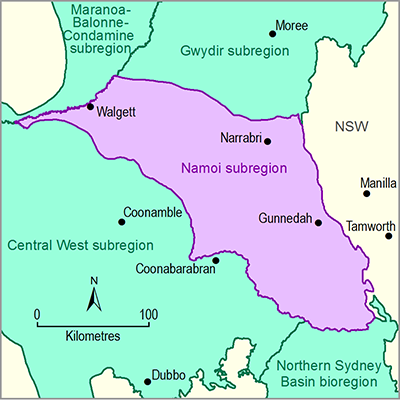2.6.2.4.2.1 Recharge
There are three components to the recharge as applied to the Namoi subregion groundwater model, these are: diffuse recharge due to rainfall, flood recharge due to overbank flooding from the river, and irrigation recharge under areas that are irrigated. They were implemented in the model using the Recharge (RCH) package for MODFLOW-USG.
Rainfall recharge is spatially and temporally varying, reflecting spatial differences in near-surface geology and temporal variation in rainfall. The derivation of a mean annual recharge surface for the Namoi subregion using a chloride mass balance approach is described in Section 2.1.3 of companion product 2.1-2.2 for the Namoi subregion (Aryal et al., 2018a). The temporal variation of rainfall recharge is provided by the Australian Water Resources Assessment (AWRA) landscape model (AWRA-L) (see companion product 2.6.1 for the Namoi subregion for details (Aryal et al., 2018b)). This is normalised so its average throughout the period 1983 to 2012 is 1, and the resultant time series is multiplied by the spatial variation from the chloride mass balance to yield the final spatial and temporally varying recharge as applied to the model (more details of this process are in Crosbie et al. (2015)).
In addition to the rainfall recharge, groundwater inflows from flood and irrigation recharge were added to the recharge package. The depth of flood and irrigation recharge is calculated on a daily time step at the reach scale in the AWRA river model (AWRA-R) (for details see companion product 2.6.1 for the Namoi subregion (Aryal et al., 2018b)). The reaches that contain floodplain and irrigation areas are shown in Figure 12. Flood and irrigation recharge are applied to the groundwater model cells that are contained within the floodplain and irrigation areas.
Recharge is applied as a source of water of prescribed rate to the land surface of the model. To account for uncertainties in both the temporal and spatial variation of recharge, its magnitude is varied in the uncertainty analysis for each of the three components (see companion submethodology M07 (as listed in Table 1) for groundwater modelling (Crosbie et al., 2016)).
AWRA-R = Australian Water Resources Assessment river model
Data: Bioregional Assessment Programme (Dataset 1)
2.6.2.4.2.2 Evapotranspiration
Evapotranspiration is represented by a sink of groundwater applied across the entire land surface of the model using the EVT package in MODFLOW-USG. Generally in groundwater models, evapotranspiration from groundwater is assumed to be a maximum when the watertable is at ground surface, or above it (e.g. in the case of ponding). Conversely, evapotranspiration from groundwater is generally assumed to be zero when the watertable is deep below the ground surface where plant roots cannot draw water from the deep groundwater reserves. There is an analysis of the depth to watertable for the Namoi subregion in companion product 2.1-2.2 (Aryal et al., 2018a) which is indicative of where an evapotranspiration flux from groundwater may be significant. The maximum evapotranspiration rate was set as a constant across the model domain and the extinction depth was related to the vegetation height using the assumption that taller vegetation have deeper roots. The extinction depth was calculated as a quarter of the vegetation height (Figure 13) plus 1, this means that with 40 m vegetation height there is an extinction depth of 11 m and for vegetation that has zero height (i.e. bare ground) there is an extinction depth of 1 m.
Data: Caltech/JPL (Dataset 2)

Product Finalisation date
- 2.6.2.1 Methods
- 2.6.2.2 Review of existing models
- 2.6.2.3 Model development
- 2.6.2.4 Boundary and initial conditions
- 2.6.2.5 Implementation of the coal resource development pathway
- 2.6.2.6 Parameterisation
- 2.6.2.7 Observations and predictions
- 2.6.2.8 Uncertainty analysis
- 2.6.2.9 Limitations
- Citation
- Currency of scientific results
- Acknowledgements
- Contributors to the Technical Programme
- About this technical product


